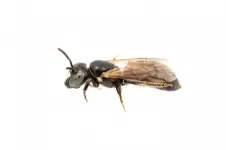(Press-News.org) A widespread field search for a rare Australian native bee not recorded for almost a century has found it's been there all along - but is probably under increasing pressure to survive.
Only six individual were ever found, with the last published record of this Australian endemic bee species, Pharohylaeus lactiferus (Colletidae: Hylaeinae), from 1923 in Queensland.
"This is concerning because it is the only Australian species in the Pharohylaeus genus and nothing was known of its biology," Flinders University researcher James Dorey says in a new scientific paper in the journal Journal of Hymenoptera Research.
The hunt began after fellow bee experts Olivia Davies and Dr Tobias Smith raised the possibility of the species' extinction based on the lack of any recent sightings. The 'rediscovery' followed extensive sampling of 225 general and 20 targeted sampling sites across New South Wales and Queensland.
Along with extra bee and vegetation recordings from the Atlas of Living Australia, which lists 500 bee species in NSW and 657 in Queensland, the Flinders researchers sought to assess the latest levels of true diversity warning that habitat loss and fragmentation of Australia's rainforests, along with wildfires and climate change, are likely to put extinction pressure on this and other invertebrate species.
"Three populations of P. lactiferous were found by sampling bees visiting their favoured plant species along much of the Australian east coast, suggesting population isolation," says Flinders University biological sciences PhD candidate James Dorey.
Highly fragmented habitat and potential host specialisation might explain the rarity of P. lactiferus.
Australia has already cleared more than 40% of its forests and woodlands since European colonisation, leaving much of the remainder fragmented and degraded (Bradshaw 2012).
"My geographical analyses used to explore habitat destruction in the Wet Tropics and Central Mackay Coast bioregions indicate susceptibility of Queensland rainforests and P. lactiferus populations to bushfires, particularly in the context of a fragmented landscape," Mr Dorey says.
The study also warns the species is even more vulnerable as they appear to favour specific floral specimens and were only found near tropical or sub-tropical rainforest - a single vegetation type.
"Collections indicate possible floral and habitat specialisation with specimens only
visiting firewheel trees, Stenocarpus sinuatus (Proteaceae), and Illawarra flame
trees, Brachychiton acerifolius (Malvaceae), to the exclusion of other available floral
resources."
Known populations of P. lactiferus remain rare and susceptible to habitat destruction
(e.g. from changed land use or events such as fires), the paper concludes.
"Future research should aim to increase our understanding of the biology, ecology
and population genetics of P. lactiferus."
"If we are to understand and protect these wonderful Australian species, we really
need to increase biomonitoring and conservation efforts, along with funding for the museum curation and digitisation of their collections and other initiatives," Mr Dorey says.
INFORMATION:
The new paper, 'Missing for almost 100 years: the rare and potentially threatened bee, Pharohylaeus lactiferus (Hymenoptera, Colletidae) 2021 by JB Dorey has been published in The Journal of Hymenoptera Research. 81: 165-180. https://doi.org/10.3897/jhr.81.59365
Immunologists at St. Jude Children's Research Hospital have mapped the previously unknown biological machinery by which the immune system generates T cells that kill bacteria, viruses and tumor cells.
The findings have multiple implications for how the adaptive immune system responds to infections to generate such memory T cells. The experiments revealed mechanisms that inhibit development of the long-lived memory T cells that continually renew to protect the body over time. Blocking these inhibitory mechanisms with pharmacological or genetic approaches could boost protective immunity against infection and cancers.
The researchers also discovered a subtype of memory T cells that they named terminal effector prime cells. Mapping the pathway that controls these cells raises the possibility ...
(Boston)--What if you could improve your heart health and brain function by changing your diet? Boston University School of Medicine researchers have found that by eating more plant-based food such as berries and green leafy vegetables while limiting consumption of foods high in saturated fat and animal products, you can slow down heart failure (HF) and ultimately lower your risk of cognitive decline and dementia.
Heart failure (HF) affects over 6.5 million adults in the U.S. In addition to its detrimental effects on several organ systems, presence of HF is associated with higher risk of cognitive decline and dementia. Similarly, changes in cardiac structure ...
When building a nest, previous experience raising chicks will influence the choices birds make, according to a new study by University of Alberta scientists.
The results show that birds that have successfully raised families stick with tried-and-true methods when building their nests, whereas less successful birds will try something new.
"We found that when presented with a choice between a familiar material, coconut fibre, and a never-before-encountered material, white string, zebra finches who had successfully raised chicks preferred to stick with the same material they had previously used. Birds who failed to raise chicks built nests with equal amounts of familiar and novel material," explained ...
America's stark racial disparities in health care have been exposed by COVID-19, but a new study from Michigan State University suggests that Black individuals are more likely than conservative White people to adhere to public health standards due to disparities.
The study, published in the Journal of Racial and Ethnic Health Disparities, used data from MSU's State of the State Survey that was captured during the initial COVID-19 outbreak from a representative group of 800 adults in Michigan.
"Our findings suggest that although COVID impacts all Michiganders, ...
Fiber-optic cables run underneath nearly all city grids across the United States and provide internet and cable TV to millions, but what if those systems could also provide valuable information related to hazardous events such as earthquakes and flooding? A team of researchers at Penn State have found they can do just that.
The scientists are using fiber-optic distributed acoustic sensing (DAS) technology to turn existing telecommunication infrastructure that is already installed underground into a valuable resource for monitoring ground vibrations.
"We discovered the fibers could pick up a wide variety of signal vibrations, from thunderstorms to human walking steps to music concerts," said Tieyuan Zhu, assistant professor of geophysics at Penn State and principal investigator on ...
American Geophysical Union U.S. Geological Survey Joint ReleaseWASHINGTON--Southern California can now expect to see post-wildfire landslides occurring almost every year, with major events expected roughly every ten years, a new study finds. The results show Californians are now facing a double whammy of increased wildfire and landslide risk caused by climate change-induced shifts in the state's wet and dry seasons, according to researchers who mapped landslide vulnerability in the southern half of the state.
"This is our attempt to get people thinking about where these hazards are going to be before there's even a fire," said Jason Kean, a hydrologist at the U.S. Geological Survey in Denver and lead author ...
HOUSTON - (Feb. 25, 2021) - A new theory by Rice University scientists could boost the growing field of spintronics, devices that depend on the state of an electron as much as the brute electrical force required to push it.
Materials theorist Boris Yakobson and graduate student Sunny Gupta at Rice's Brown School of Engineering describe the mechanism behind Rashba splitting, an effect seen in crystal compounds that can influence their electrons' "up" or "down" spin states, analogous to "on" or "off" in common transistors.
"Spin" is a misnomer, since quantum physics constrains electrons ...
BUFFALO, N.Y. -- Graphene is incredibly strong, lightweight, conductive ... the list of its superlative properties goes on.
It is not, however, magnetic -- a shortcoming that has stunted its usefulness in spintronics, an emerging field that scientists say could eventually rewrite the rules of electronics, leading to more powerful semiconductors, computers and other devices.
Now, an international research team led by the University at Buffalo is reporting an advancement that could help overcome this obstacle.
In a study published today in the journal Physical Review Letters, researchers describe how they paired a magnet with graphene, and induced what they describe as "artificial magnetic texture" in the nonmagnetic wonder material.
"Independent of each ...
As climate change increases the occurrence of catastrophic natural disasters around the world, international organizations are looking for ways to reduce the risk of such disasters. One approach under exploration is the humanitarian community's forecast-based early action (FbA), which seeks to enable pre-emptive actions based on forecasts of extreme events.
With FbA, disaster response shifts toward anticipating disasters to ameliorate their destructive effects. However, the development of data-based triggers and metrics for action rely on timely and accurate information. A group of researchers publishing in SPIE's END ...
HOUSTON - (Feb. 25, 2021) - COVID-19 can be diagnosed in 55 minutes or less with the help of programmed magnetic nanobeads and a diagnostic tool that plugs into an off-the-shelf cell phone, according to Rice University engineers.
The Rice lab of mechanical engineer Peter Lillehoj has developed a stamp-sized microfluidic chip that measures the concentration of SARS-CoV-2 nucleocapsid (N) protein in blood serum from a standard finger prick. The nanobeads bind to SARS-CoV-2 N protein, a biomarker for COVID-19, in the chip and transport it to an electrochemical sensor that detects minute amounts of the biomarker.
The ...







